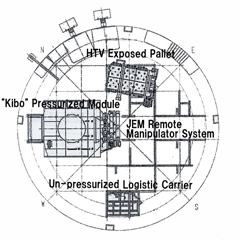
Kibo's Extravehicular Activity Procedure Development Test No. 6 (OPS #6)
 |
 |
| Astronaut Wakata and Astronaut Wolf preparing for the test. |
OPS #6 view |
From October 24 to November 4, 2005, Kibo's Extravehicular Activity (EVA) Procedure Development Test No. 6 (OPS #6) was conducted in the Weightless Environment Test Building (WET) at Tsukuba Space Center (TKSC). JAXA astronaut Koichi Wakata and NASA astronaut David Wolf participated in the OPS #6 test.
The purpose of OPS #6 was to conduct procedure development*1 and design verification*2 of the Japanese Experiment Module, Kibo, and of the H-II Transfer Vehicle (HTV), currently being developed by Japan for use in transporting cargo to the ISS.
*1. In procedure development, procedures for on-orbit assembly and maintenance of the ISS are developed in advance.
*2 Design verification validates that Kibo has been adequately designed to enable EVA activities.
 What is OPS #6? What is OPS #6?
Kibo's elements will be launched to orbit by three space shuttle flights and will be assembled using the Remote Manipulator System (RMS) and EVA activities.
This test was conducted to establish more efficient Kibo assembly EVA procedures by confirming the assembly task details, such as the assembly order, the astronauts' movements during the EVA, and the time required to complete these operations.
During this test, the astronauts wore underwater space suits and confirmed and validated the assembly procedures using a full-scale mockup of Kibo and related elements, while working in the water pool located in the Weightless Environment Test (WET) building at TKSC.
 Description of OPS #6 Description of OPS #6
 |
| Layout of the mock-ups (as seen from above the pool.) |
In OPS #6, two astronauts followed the on-orbit assembly procedure of Kibo's Pressurized Module (PM) and Exposed Facility (EF) by assembling the mock-ups under water, thus verifying their working coordination and the time required to complete the various tasks.This was the first time since 1998 that two astronauts wearing underwater space suits simultaneously conducted the test under water.In addition, the design of HTV's Exposed Palette (EP) was verified by simulating the EVA tasks to detach the mockup batteries, located on the EP, while assuming some abnormality had occurred.
 Kibo-related tasks Kibo-related tasks
The primary verification procedures were as follows.
- "Kibo" Pressurized Module (PM) assembly related tasks
- Removing the multi-layer insulator (MLI) covers from the robotic arm's six joints and the End Effector, before deploying the JEM Remote Manipulator System.
- Transporting and installing the external cameras to be attached to the outside of the PM, using the Orbital Replacement Unit (ORU) bag.
- Inspecting the PM/EF Berthing Mechanism (BM) and installing the MLI covers.
- Clearance check of the Canadarm2 (SSRMS) and grapple fixture.
- Clearance check for installing the camera when the ELM-ES is attached to the Exposed Facility Unit (EFU).
- Removing the MLI covers and releasing the launch locks.
- Removing the MLI covers from the active half of the Common Berthing Mechanism (CBM).
- Deploying the debris shield petal of the CBM.
- Releasing the launch locks of the CBM hatch.
- Installing the camera and its supporting structure.
- Kibo Exposed Facility (EF) assembly related tasks
- Disconnecting the camera's interface cables.
- Installing the camera on the EF.
- Removing the MLI covers from the Equipment Exchange Units (EEUs).
- Removing the MLI covers from the Small Fine Arm (SFA) storage equipment.
- Removing the MLI covers from the ORU.
- Installing and activating the Inter-orbit Communication System (ICS), and removing the MLI covers.
- Design verification
- Deployment of the CBM debris shield cover.
- Replacing the emblem.
- Procedure development
- Removing the MLI covers on the passive half of the Berthing Mechanism (BM).
- Installing the MLI covers on the Remotely Operated Electrical Umbilical (ROEU) (NASA Task).
- Releasing the grapple fixture.
 HTV-Related Tasks HTV-Related Tasks
The primary verification procedures were as follows.
- HTV Exposed Pallet (EP) related tasks
- Removing the failed Canadarm2 End Effector attached to the battery located on the HTV-EP.
- Detaching the Canadarm2 End Effector from the HTV-EP.
- Securing the battery to the handhold using tethers.
- Replacing the battery when the robotic arms failed.
- Manually releasing the HTV Cargo Attachment Mechanism (HCAM).
- Securing the payloads to the handhold using tethers.
- HTV Un-pressurized Logistic Carrier (ULC) related tasks
- Contingency release of the SSRMS End-Effector (EE) and ULC's Grapple Fixture (removing the Grapple Fixture's grapple shaft).
- Contingency release due to failure of the Tie-down / Separation Mechanism (TSM) and Harness Separation Mechanism (HSM), while removing the HTV- EP from the HTV ULC.
 |
 |
| Astronaut Wakata wearing an underwater space suit. |
NASA Astronaut Wolf wearing an underwater space suit. |
|
 |
 |
| Astronaut Wakata submerging. |
NASA Astronaut Wolf submerging. |
|
|
 |
 |
| Mission Control Center |
|
 Press Conference Press Conference
 |

(13min 19sec) |
On October 25, 2005, the test was opened to the press and attracted many reporters. After the test was completed, Astronaut Wakata and NASA Astronaut Wolf held a press conference. Astronaut Wakata told the reporters that the design verification of the Kibo-related and HTV-related EVA had been very successful.
Last Updated: March.28,2006
|
